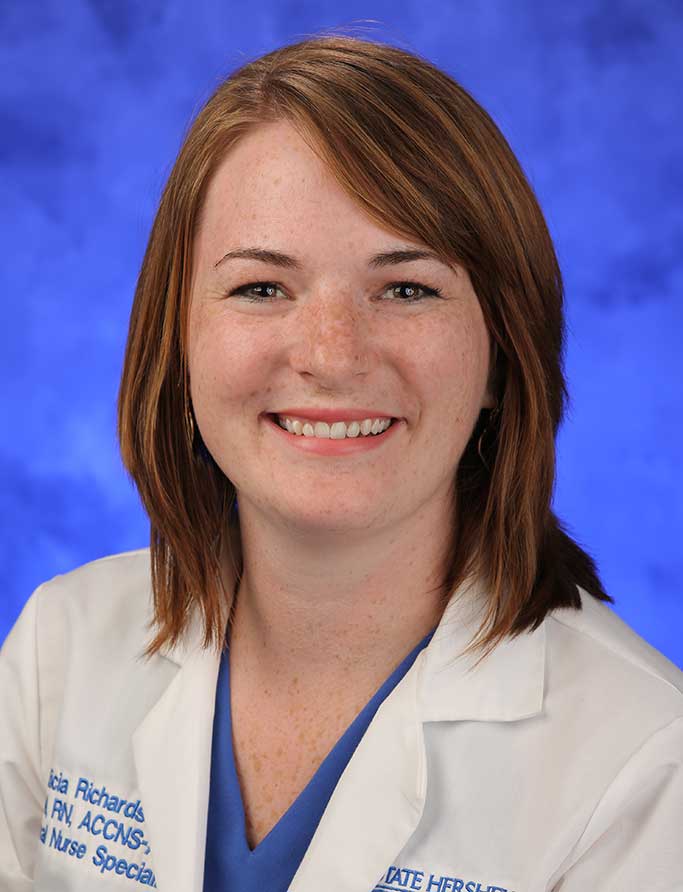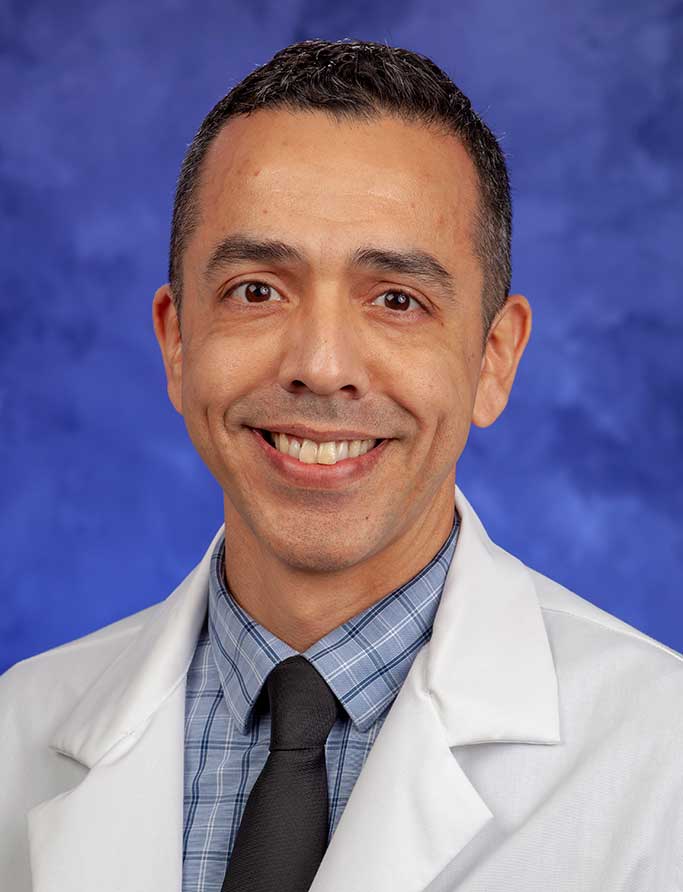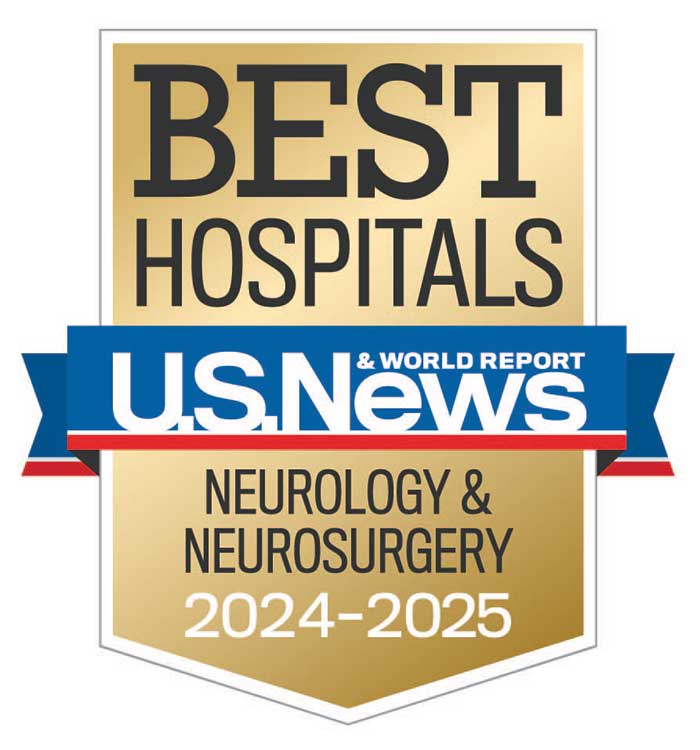Clots and Coffee creatively teaches hospital providers about stroke risk
Most strategies to educate in-hospital providers about recognizing and responding to symptoms of stroke include some sort of slide presentation. But Alicia Richardson, MSN, RN, ACCNS-AG, and Cesar Velasco, BSN, RN, Stroke Program coordinators at Penn State Health Milton S. Hershey Medical Center, get far more creative.
On a Wednesday morning in May, Richardson dressed in costume as a blood clot, affixing red balloons to her scrubs. Velasco donned a red cape and a nametag that read, “Hello, my name is Stent.” Together, they asked staff on the Milton S. Hershey Medical Center Heart and Vascular Intensive Care Unit (HVICU) rapid-fire questions about stroke treatments and symptoms, teaching, for example, which symptoms call for tPA or thrombectomy as the preferred stroke treatment option.
It’s part of Clots and Coffee, a fun and important pop-up educational program that rotates throughout inpatient units at both Hershey Medical Center and Penn State Health Children’s Hospital twice each year. Richardson and her team bring coffee, doughnut holes and memorable costumes to hospital staff members, while also sharing a lifesaving message: how to recognize and respond to stroke properly.
“It’s important to do outreach education for the community, but we find it is equally important to keep educating our staff on the signs and symptoms of stroke care,” Velasco said. “We have patients who are here for multiple reasons, and any of these patients could potentially have a stroke.”In-hospital strokes account for up to nearly one in five strokes, according to a recent article in the Journal of Stroke and Cerebrovascular Diseases. Earlier recognition of stroke results in better clinical outcomes, presumably due to faster diagnosis and subsequently, prompt treatment.
To ensure rapid treatment, the Stroke Program coordinators design the Clots and Coffee sessions to deliver two main messages: remain vigilant for stroke symptoms and call the Department of Neurology’s dedicated Stroke Team at the first sign of symptoms. The hospital’s Stroke Team is available 24/7.
“We care for patients who come here for everything from cancer treatment to orthopedic or internal medical reasons, and any of these patients could potentially have a stroke while they are in the hospital,” Velasco said. “We have had several success stories where people experienced a stroke in the inpatient setting and have avoided any long-term deficits because staff recognized the symptoms and gave the patients treatment promptly.”
While originally designed for adult health care providers, Clots and Coffee recently expanded to the Children’s Hospital, recognizing the strong link between strokes and specific pediatric health conditions. “Certain risk factors, like congenital heart disease or sickle cell anemia, can put a child at higher risk,” Richardson said. “We want to spread awareness that children can have a stroke, and our staff needs to act quickly, so we don’t miss out on treatment opportunities.”
Hershey Medical Center physicians have seen the value in the Clots and Coffee talks. “What the team is doing is very important,” says intensivist Dr. Ricarda White, an internist fellowship-trained in both critical care medicine and cardiology at the medical center “Sometimes we get patients post-surgery who may have neurologic changes, and we just call a brain attack right away. The team helps us facilitate getting the treatment in a timely fashion.”
The medical center’s nurses and front-line providers also appreciate the outreach. “Our focus is mainly on the heart, but it’s important to remember the risk for stroke,” says HVICU nurse Cyndill Seveses, RN. “It’s also good to know the stroke team will be here to help if a patient has a brain attack.”
Hershey Medical Center is one of only seven health care facilities in Pennsylvania — and the first in central Pennsylvania — certified as a Comprehensive Stroke Center, the highest designation from The Joint Commission and the American Heart Association/American Stroke Association.

Alicia Richardson, MSN, RN, ACCNS-AG
Stroke Program Manager
Connect with Department of Neurology on Doximity

Cesar Velasco, BSN, RN
Stroke Program Coordinator
Connect with Department of Neurology on Doximity

Kevin M. Cockroft, MD, MSc, FAANS, FACS, FAHA
Co-Director, Penn State Health Stroke Center
Interim Chair, Department of Neurosurgery, Penn State College of Medicine
Professor, Departments of Neurosurgery, Radiology and Public Health Sciences
Phone: 717-531-3828
Email: kcockroft@pennstatehealth.psu.edu
Fellowship: Interventional/Vascular, Thomas Jefferson University Hospital, Philadelphia, Pa.; Neurological Surgery, Stanford University Hospital, Stanford, Calif.
Residency: Neurological Surgery, The New York Hospital-Cornell Medical Center, New York, N.Y.
Medical School: Cornell University Medical College, New York, N.Y.
Connect with Kevin M. Cockroft, MD, MSc, FAANS, FACS, FAHA, on Doximity

Raymond K. Reichwein, MD
Professor of Neurology, Penn State College of Medicine
Chief, Division of Stroke
Comprehensive Stroke Center Co-Medical Director
Penn State Health Rehab Stroke Program Director
Phone: 717-531-1803
Email: rreichwein@pennstatehealth.psu.edu
Fellowship: Neurophysiology, Penn State Health Milton S. Hershey Medical Center, Hershey, Pa.
Residency: Neurology, Penn State Health Milton S. Hershey Medical Center, Hershey, Pa.
Medical School: Penn State College of Medicine, Hershey, Pa.
Connect with Raymond K. Reichwein, MD, on Doximity
Reference
Yang SJ, Franco T, Wallace N, Williams B, Blackmore C. Effectiveness of an Interdisciplinary, Nurse Driven In-Hospital Code Stroke Protocol on In-Patient Ischemic Stroke Recognition and Management. J Stroke Cerebrovasc Dis. 2019;28(12):104398. doi:10.1016/j.jstrokecerebrovasdis.2019.104398

